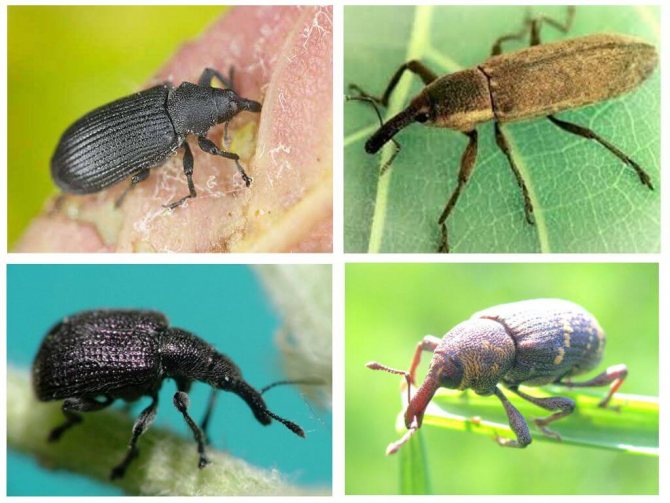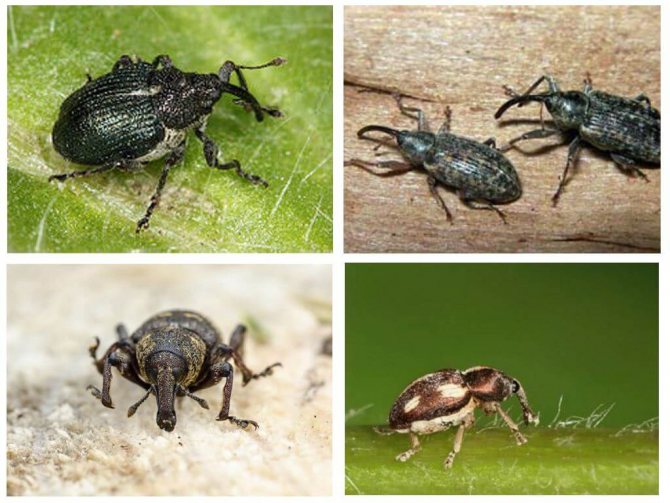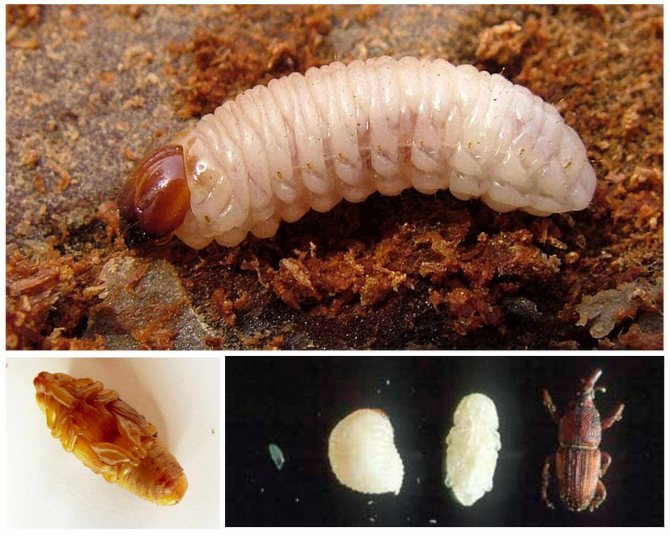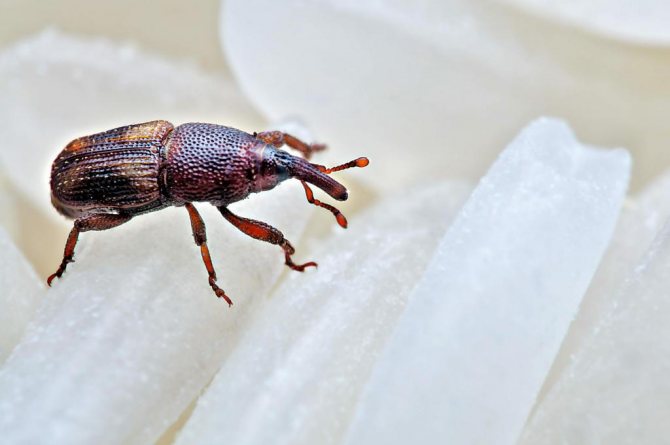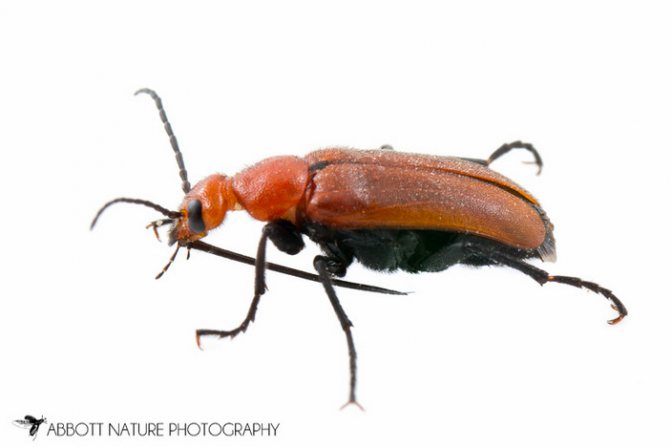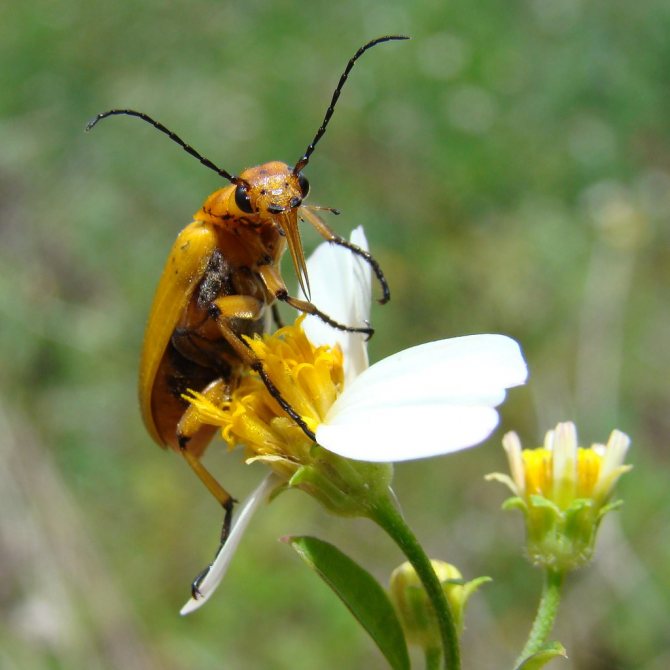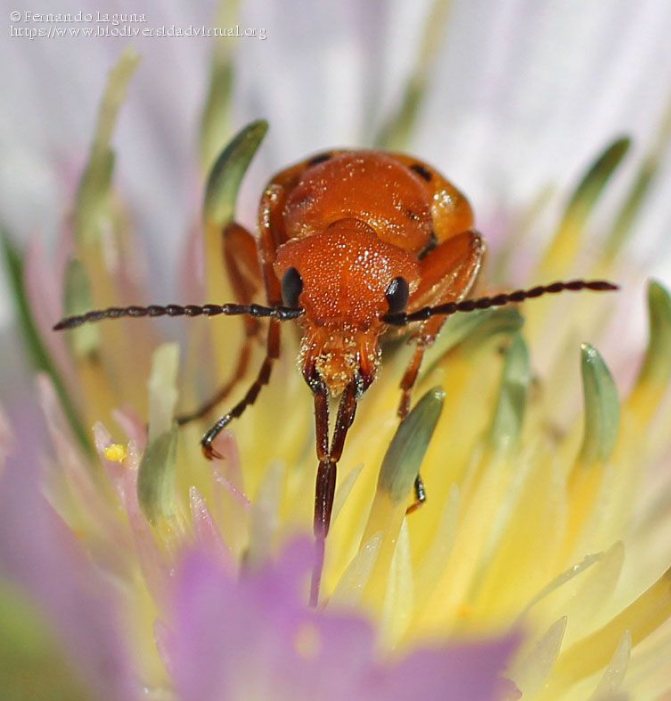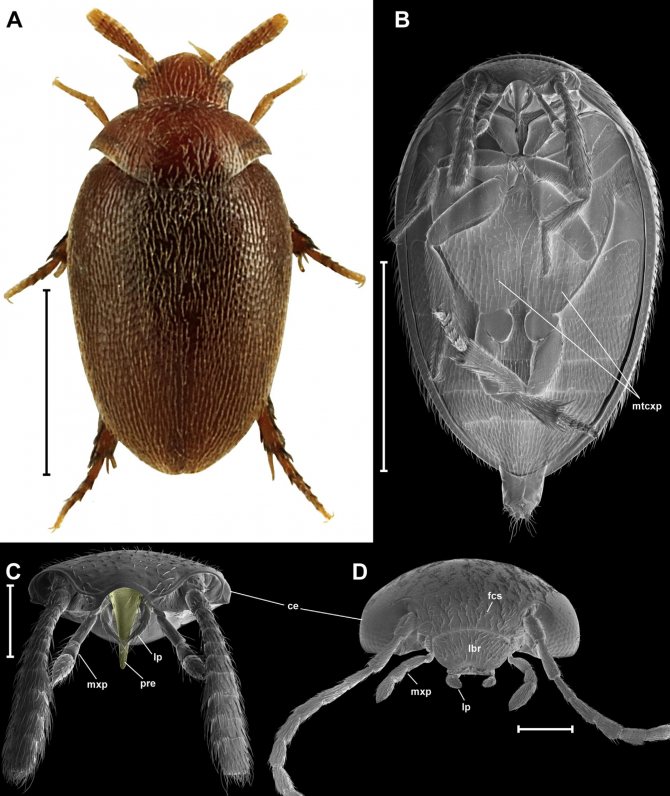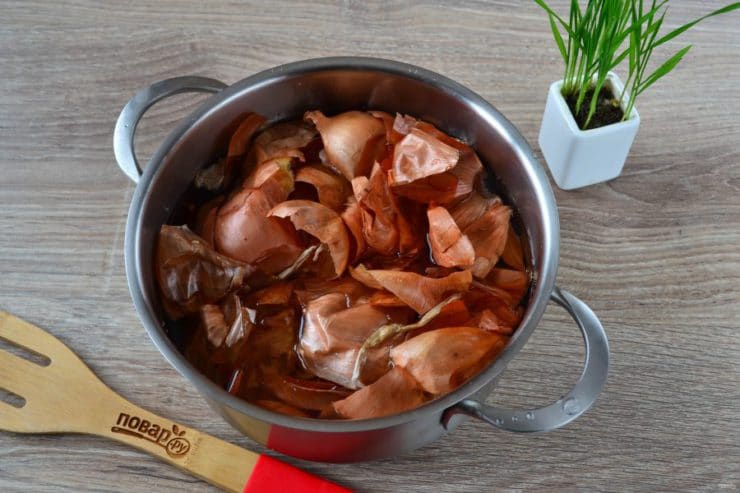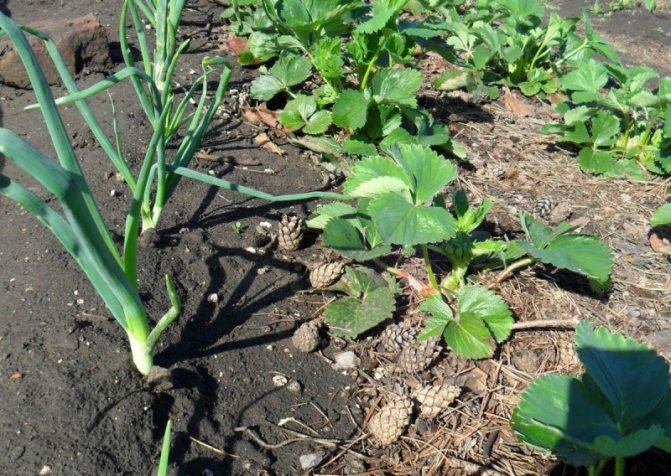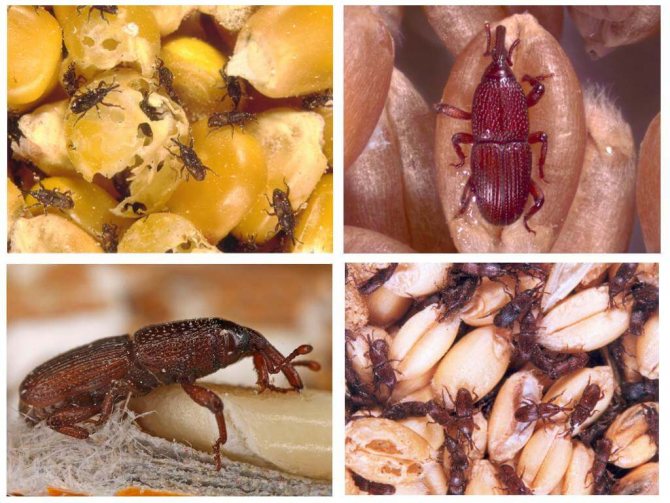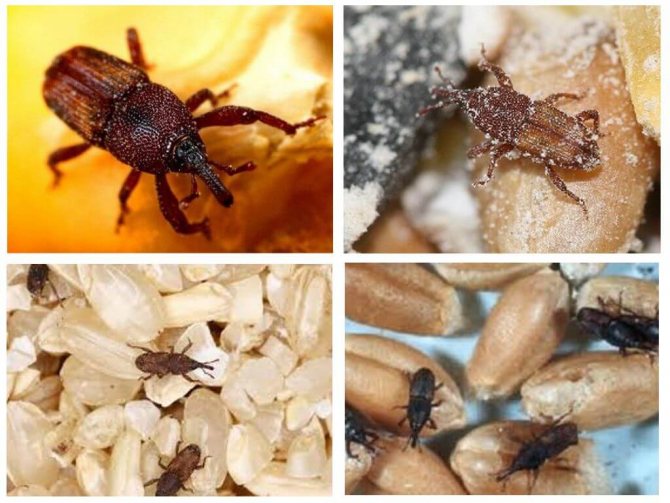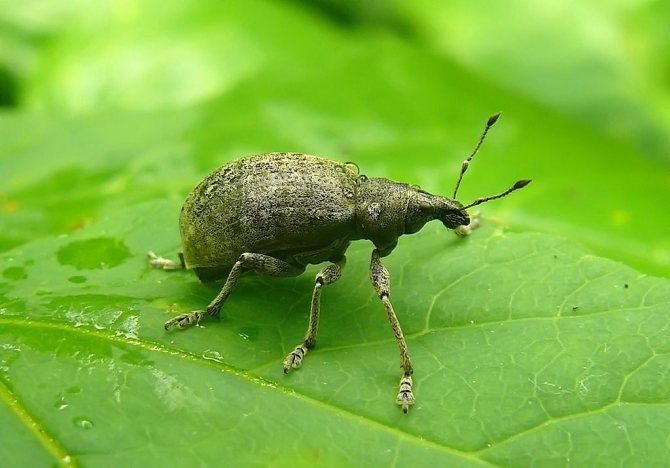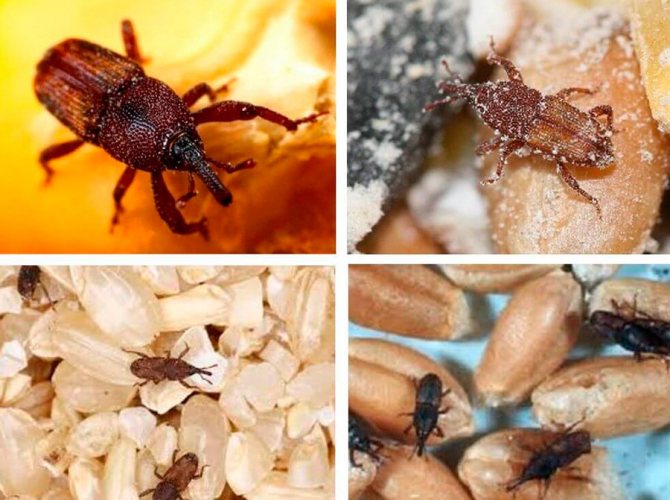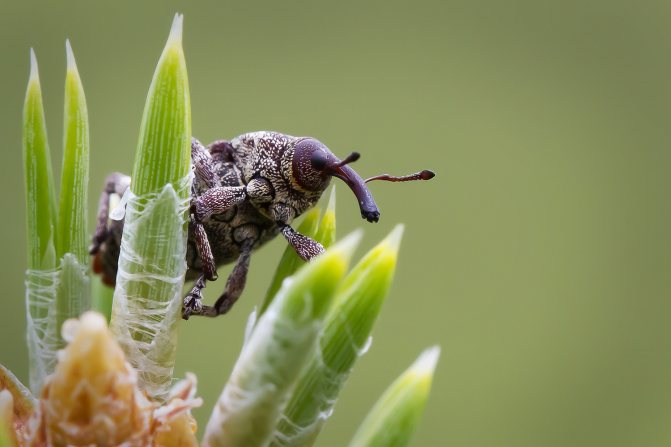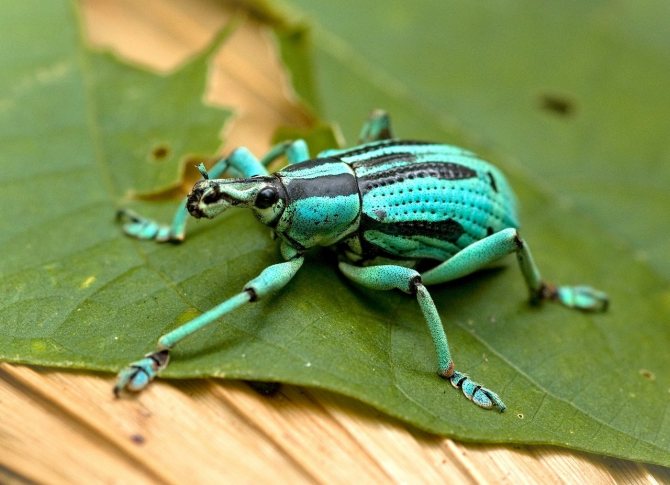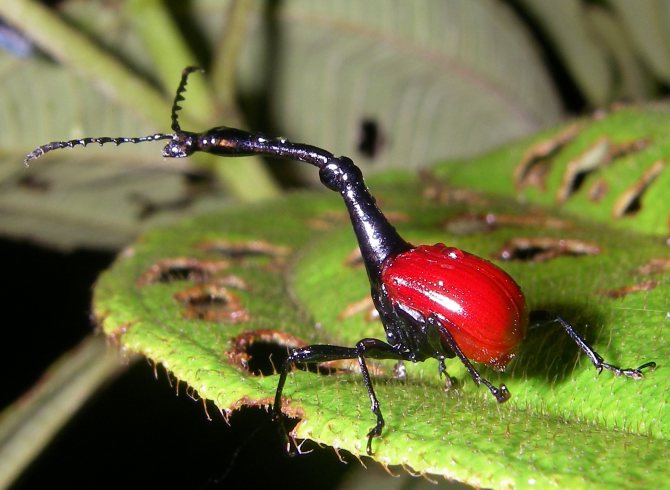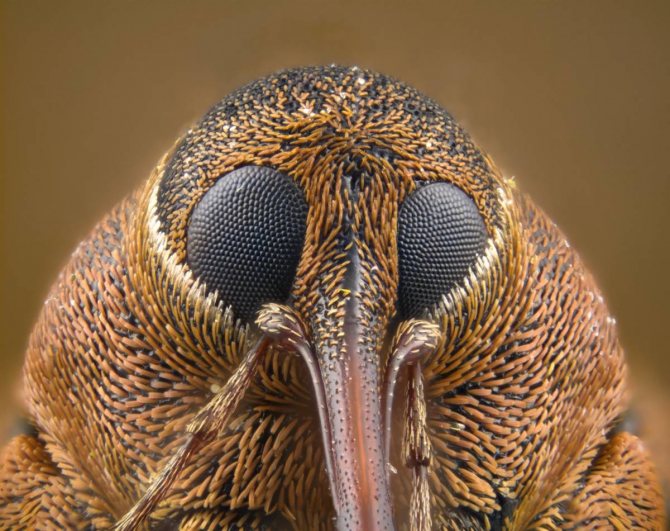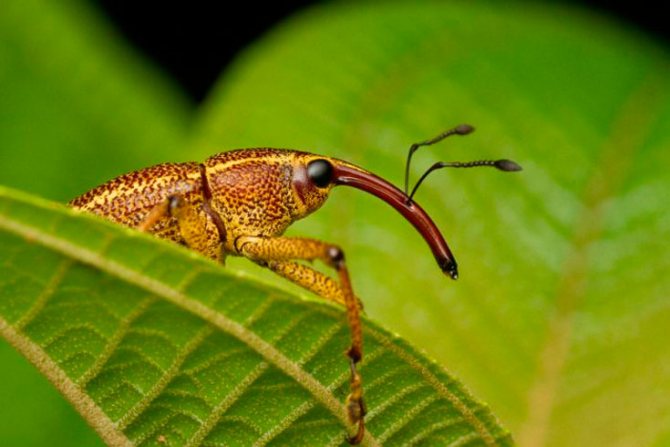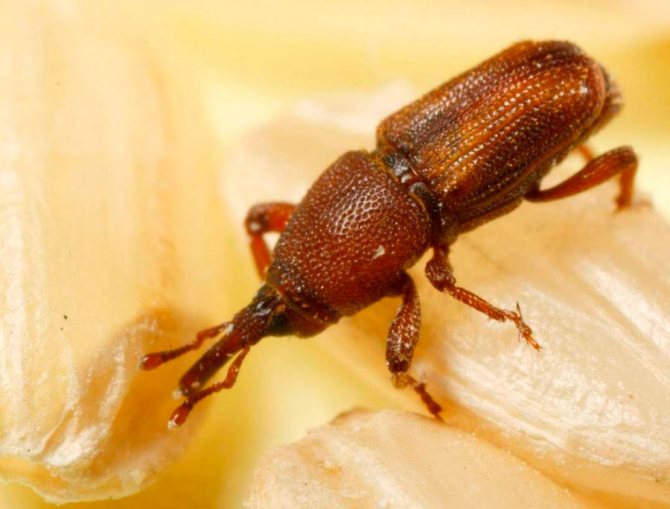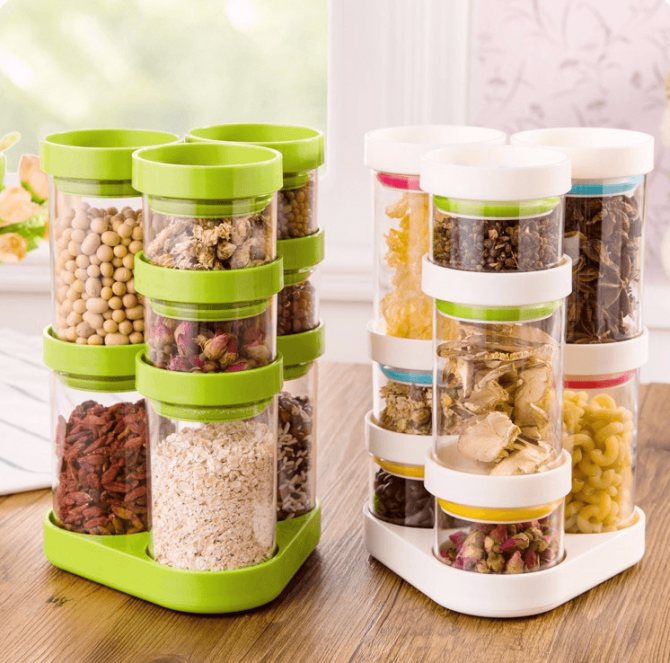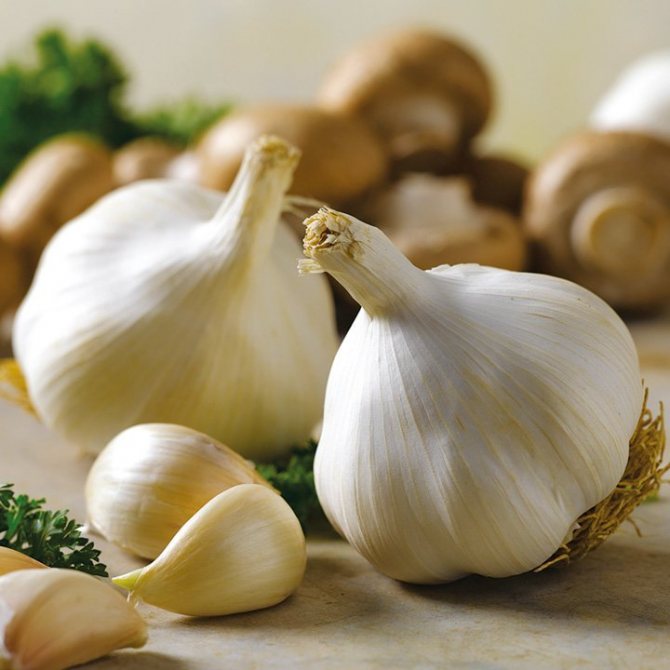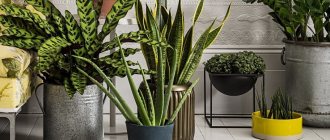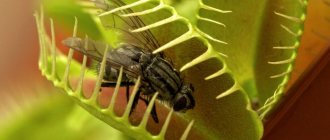The weevil beetle belongs to one of the many species of the Coleoptera family. Very often they are called elephants or skosars. Such a harmless name hides one of the dangerous insects that destroy almost all known species of flora. The family of weevils (lat.Curculionidae) belongs to the order Coleoptera, one of the largest among this species of beetles. Their number reaches seventy thousand. Mostly elephants live in tropical countries. On the territory of Russia, about five thousand species of beetles have been recorded.
Who to fight with: photo and description of weevils
Weevils are dangerous pests of vegetables and grains. The ancient Egyptians fought with them several millennia ago. These beetles of the order Coleoptera have about 50,000 species. Adult insects reach 2-4 mm, have a dark brown color and a characteristic elongated front part of the head. Beetles have poorly developed wings that they cannot use.
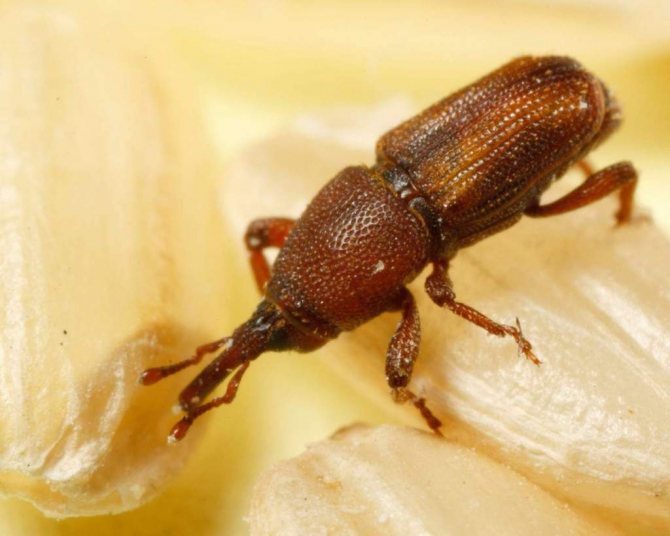
The life span of insects ranges from 7 months to 2 years. A female insect can lay 2-3 clutches per year, each time 200-300 eggs per grain of cereal. Weevils live in the apartment, mainly of the following species:
- the granary is the most insatiable of its kind. Likes to settle in the kitchen and eat supplies of cereals and flour;
- rice - can start in buckwheat or rice cereals, does not disdain bakery products;
- nutty - chooses places for storing nuts for his dwelling;
- Dubovik - loves acorns, but if he settles in houses, he does not refuse those food supplies that he has;
- beet - can live in gardens, vegetable gardens, using vegetables and fruits for food.
On a note!
The female weevil lays only one egg in each grain or grain. This provides the larva with sufficient food until adulthood.
The main types of weevils
It is not possible to describe what the weevil and their larvae look like, of all the most common species on the territory of Russia. Let's try to briefly describe some of the representatives:
- Barn weevil. A small bug with underdeveloped wings. It spread throughout the world with grain crops and became a dangerous detachment of granary pests. Females lay up to three hundred eggs, one at a time, in holes made in grains of wheat, corn, barley, rye and other cereals. In addition to the larva, adults also harm grain. The large degree of damage makes the supplies completely unsuitable for food. Among the barn beetles that destroy a large amount of grain reserves, there are: rice weevil, corn barn and wide-lumped rice weevil.
- Beetroot elephant. Dangerous for sugar beets. A large beetle with a short proboscis is covered with a dense cover of ash-gray scales. They appear on agricultural fields in spring and feed on weeds before the emergence of beets. They destroy the young growth of culture. The larvae develop in the soil near the root crop, damaging its main root. As a result, the quality indicators of sugar beet are reduced.
- Striped nodule weevil. The pest feeds on legumes.Adults prefer the stems and leaves of plants, and the larvae of the weevil beetle destroy the root system. Females are capable of laying up to three thousand eggs per season. The size of the beetle reaches 5 mm.
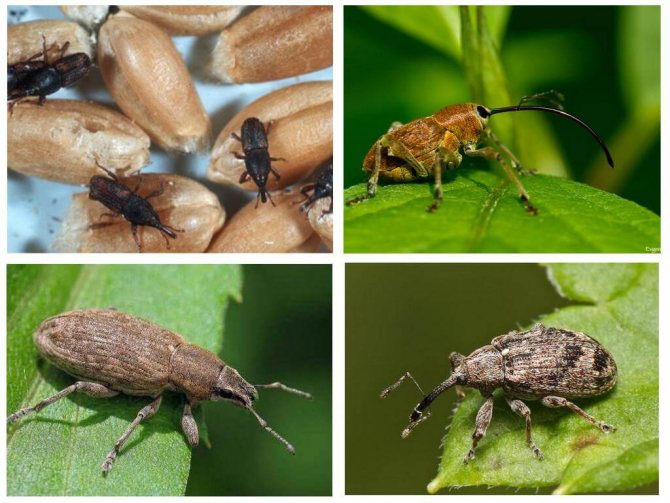

Weevil species - Fruit pests. They cause irreparable harm to trees, destroying all parts of plants - ovary, young shoots, flowers, bark and wood. The most common are vetch fruit, Crimean, cherry black and other types of dangerous pests of fruit-bearing trees.
- Berry weevil. They destroy the plantings of strawberries, raspberries, blackberries, strawberries, grapes and other crops. A typical representative of this group of pests is the strawberry elephant, hibernating under the bushes of strawberries, and with the onset of spring parasitizing on the bushes of the plant.
- Acorn elephant. It differs from its relatives in a very long, thin proboscis, the length of which is almost equal to the size of the body. At the end of the proboscis there are strong jaws that serve as a drilling machine. Females lay eggs in ripe oak acorns. The female spends an average of eight hours to drill a hole in the fetus. The larva develops in the middle of the acorn, feeding on juicy pulp. Having reached a mature state, she gnaws through the outer shell of her house and buries herself in the soil. Pupation occurs in the spring.
- Ussuri or buckwheat weevil. Destroys crops and crops of valuable crops.
It is not possible to list all representatives of weevils and note the distinctive features of each representative.
Where do weevils come from in apartments and why they should be removed
A weevil in cereals enters the dwelling, which housewives bring from stores or from market layouts. If no action is taken to destroy insects in warehouse or granary storage facilities, they are kept in supplies. It is very difficult to spot a bug colony in prepackaged foods. Since each grain in which an egg is laid is neatly sealed with a specific mucus. Subsequently, it becomes solid, reliably closing the future bug. Thus, insects can be seen much later than their appearance in purchased products.
Getting rid of weevils in the kitchen is worth not only because they transfer food, but because they are carriers of fungal infections and bacteria that are dangerous to humans. Their secretions can cause various allergic reactions. Therefore, at the first signs of appearance, you need to fight them with all available means.
Important!
It is almost impossible to spot the weevils. Their larvae resemble grains of semolina stuck together. Therefore, they cannot be seen in flour, but they can be easily identified in buckwheat and nuts.
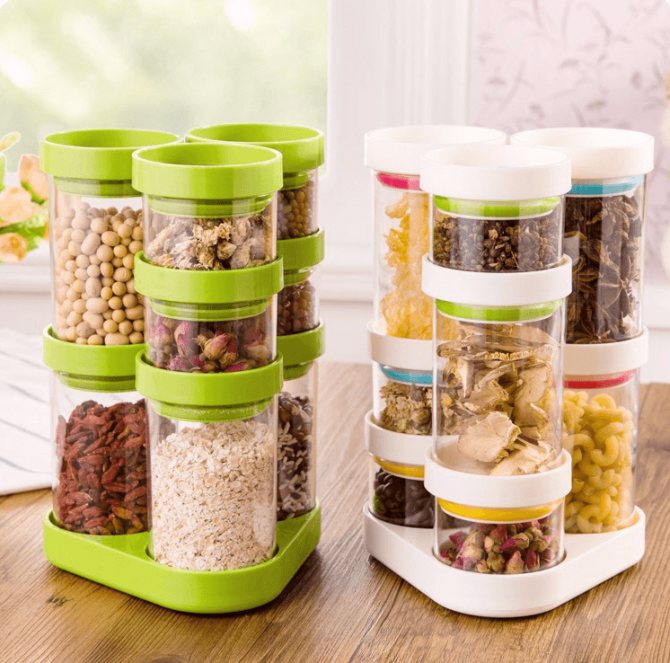

What is the danger of elephants


Rice elephant
In addition to the fact that they spoil products, turning them into dust, they can cause allergic reactions, accompany the disease with allergic alveolitis. Leaving microparticles of its chitinous membrane in the flour, carcinogenic secretions that turn into the finished product after baking, contribute to the occurrence of infections and malfunctions in the gastrointestinal tract. Pathogenic fungi and bacteria are introduced into products. In doing so, they travel from one cereal to another or into flour.
Features of the reproduction of weevils in the apartment
If weevils appeared in a house or apartment, it means that they were brought in from the outside, and in such a room there are ideal conditions for reproduction for them. When the female insect is about to lay an egg, she gnaws a hole in the grain, then seals it with secretions. On the 12th day, a larva hatches from the egg, which then turns into a pupa. A formed adult is already emerging from the pupa. The most suitable conditions for the emergence of new bugs are temperatures above 5o, and humidity over 12 percent. A young individual makes its way into the wild by gnawing grain.
Elephant beetle: description
Each species of weevils has a specific name that characterizes its habitat and "taste preferences", respectively. These are pear, drupe and apple flower beetles, striped pea and raspberry-strawberry weevils, hairy leaf elephants, nut fruit borer (characterized by the longest proboscis, which mercilessly spoils the nuts). All of them are united by a long proboscis and extreme gluttony.


How to get rid of barn beetles in the kitchen
Small bugs can create big problems for housewives. It is impossible to get rid of them if only adults are identified. Hundreds of larvae can be found in cereals or flour. Therefore, if signs of their presence in the kitchen were identified, then it is necessary to arrange an audit of all stocks, without exception. There are several options for how to remove weevils:
- It is better to throw away pantry supplies, since it is very difficult to detect larvae with the naked eye.
- Another option is to heat the cereal at 50o for about 5-6 hours in the oven. Flour, on the other hand, needs to be left in the freezer for four days.
- All shelves and walls of cabinets, and secluded corners, must be thoroughly wiped with a cloth with water and soap, then with a water-vinegar solution.
- Ventilate pantry or supply cabinets well after grouting.
- If there are too many bugs, you can get rid of them with a pyrethrin spray. But first, remove all food from the cabinet. After processing, thoroughly ventilate, then put stocks back.
- Just in case, cereals that were not infected should be placed in the freezer for a couple of days.
- Loose grains and flour supplies are best stored in jars with lids that can be tightly closed.
For reference!
Weevils are rather unpretentious in food. They use rice, buckwheat, and wheat groats for food. They also enjoy eating corn, barley, pasta and flour. They also do not disdain cereals, the shelf life of which has come to an end.
Where do weevils come from
Weevils often appear in the apartment. Where they come from is of interest to many people, since bugs are very dangerous. The insect destroys all food it can get to. This pest quickly assimilates in a new environment and tolerates various natural changes quite freely.
A person himself launches weevils into the house along with products from a store or market. Cereal products are contaminated with them while still in the warehouse, and then go to packaging and store shelves.
When purchasing products with weevil faces and eggs in the store, they are very difficult to notice, since the grains remain clogged inside. And only when an adult emerges from them, it will be possible to notice traces of damage and the bugs themselves.
General conditions for the prevention and control of pests of cereals


Any housewife wants to have a stock of food on hand. But do not be too zealous, because no one is immune from the appearance of weevils. Therefore, making unnecessarily large purchases that will be stored for a long time in a warm cabinet or pantry is not worth it. The best option is to make purchases for a couple of months. The following precautions will eliminate the risk of weevils in the kitchen:
- purchased cereals can be sealed in a pact and left in the freezer for several days. If the provisions were inhabited by bugs, then the cold will simply destroy them;
- to prevent the appearance of weevils in the kitchen, you need to store cereals in tightly closed containers;
- regularly check the expiration date;
- immediately clean up spilled liquids, spilled crumbs;
- the inner space of the pantry should be wiped with soapy water from time to time. You can add a few drops of clove or eucalyptus oil to the water;
- in cabinets or pantries, you need to place bay leaves or garlic cloves;
- maintain proper storage conditions. This is a temperature of no more than 10 ° and a low level of humidity.
On a note!
The main thing is cleanliness. If you regularly clean the kitchen shelves, look through the products, then no insects will be afraid.
Folk remedies: what are rice elephants afraid of?


If there are children or animals at home, then it is highly undesirable to use strong chemicals in the fight against insects. What to do if weevils start in the apartment and how to get rid of them with folk remedies? There are a few steps you can take to get rid of the bugs harmlessly but effectively:
- After purchasing the products, they should be subjected to thermal treatments. The first option involves placing cereals in the freezer for three hours. Second, heat in the oven on a baking sheet for 20 minutes at a temperature of 50 degrees. In order for useful substances to be preserved in products, you should not leave them for a longer time.
- Microwaves are also great for fighting rice elephants. To destroy the larvae, pour the cereal into a bowl of the required volume, put it in the oven and turn it on for 2-3 minutes. Then you need to rinse and dry the cereals.
- Before placing the stocks on the shelves of the pantry, you need to treat the surface and walls with soapy water, then water with a small amount of vinegar. This precaution will keep the bugs away from stockpile locations.
- The cupboard can hold peeled garlic cloves, lavender sprigs, orange peels, bay leaves, clove seeds, mint, or peppermint gum. To effectively combat weevils, such natural repellents should be placed literally near the food and changed at least once a month.
- Slices of garlic and bay leaves placed in a container with reserves are excellent in the fight against beetles weevils. There is no need to cut or somehow specially prepare the garlic, you can simply remove the husk from it. Red pepper should be placed in the peas, and a couple of pieces of nutmeg in the flour.
Other popular methods suggest using nails and salt to keep weevils out of the apartment. With these tools, the supply containers become unavailable, and the supplies themselves are not so appetizing. Here are the following two options for how to protect products from colonization by weevils:
- Find steel nails, caps, or wire. Wash items, boil, let dry. Place in containers with cereals.
- Prepare a cloth bag and salt. Soak a bag of flour in a very concentrated salt mixture. When the material is soaked, it must be pulled out and dried.
To the hostess's piggy bank!
To check the concentration of salt in the solution, you need to take a raw egg and place it in it. If the egg does not sink, the solution is saturated.
Is chemical treatment acceptable in the kitchen
One of the few chemicals that can be used at home consists of improvised means. This includes kerosene, turpentine, liquid soap, and ammonia. The components must be mixed in equal proportions, then the slots and corners of the shelves must be treated with a solution. Before starting preventive measures, you should take children and pets out of the apartment for several hours, and then ventilate the room well. More serious chemical treatment of pantries in an apartment is simply unacceptable. But, since rice elephants like to settle in food warehouses or barns, hydrogen phosphide is used in such storage places by fumigation.
Folk methods
Many are interested in how to get rid of a weevil beetle in an apartment using folk methods. Mustard powder and water are considered good remedies. To make a solution, you need to dissolve 100 g of mustard in 3 liters of settled water. This tool can be used to process shelves in kitchen cabinets where cereals are stored, or to spray indoor plants.
Plants such as tansy, wormwood, lavender, bay leaves can be laid out on the shelves. They have a pungent smell. Mint and cloves are also good options. If you have lavender oil or extract, you can soak a cotton pad in it and leave it on the cereal shelf. Mint, citrus peel, eucalyptus have a deterrent effect. You can put unpeeled garlic cloves directly into a container with cereals.
If a rice weevil appears in an apartment, then you can scare it off by treating the possible places of their appearance with a mixture of ammonia, turpentine, kerosene and liquid soap, taken in equal proportions.
Protection of indoor plants from weevils
Although rice elephants are most often found in grain products, they also love to feast on homemade flowers. Their diet may include: hydrangea, rose, cyclamen. Insects will not only eat the flowers themselves, but also infect the root system. The flower will not live long from this. There are several ways you can get rid of bugs on balcony plants.
Popular method of dealing with bugs:
- The first option suggests preparing a solution of 100 g of mustard powder and three liters of water. Then add 40 g of laundry soap or ash. This mixture needs to be treated with indoor plants a couple of times.
- Second, make a solution with needles, garlic or onions. Mix all components and fill with water. Let it brew for two weeks. Then strain, dilute with water in a ratio of 1:10. Spray the plants with the resulting mixture once a week.
Store drugs:
- Aktara is a tool that needs to process the soil 4 times a day for 10 days. Dangerous only for pests.
- Nemabakt is a drug that does not pose a threat to humans and pets. It is enough to use once for effective pest control.
- Antonem-F is a safe, environmentally friendly drug that is similar in effect to nemabact.
Insecticides against weevils:
- Fufanon is an oily emulsion that has a paralytic effect on fatal insects. It can be dangerous to health, so it is worth working with it in a respirator. Very dangerous for the inhabitants of the water.
- Inta-Vir is an effective preparation for removing eaters of home flowers. It contains cypermethrin. One eighth tablet can be diluted in a liter of water. Spray should not be used near aquariums.
- Karbofos - is based on a sulfur-phosphorus component. It penetrates with food and thus destroys pests. The necessary precautions must be taken.
On a note!
Adult bugs can eat 100 times more food than their body weight. So, they can easily eat about 14 g of shoots or buds of domestic flowers.
Why are they dangerous
The weevil beetle appears in the apartment quite often, since it settles in cereals even in warehouses. Insect harm can be in any of its life periods. The larvae eat the stems or roots. The acorn weevil grows directly in the fruit of the oak and feeds on the inside of it.
Elephants eat almost all types of vegetation, however, pests can be divided into several varieties that use only a certain culture, namely:
- berry;
- legumes and grains;
- vegetable;
- vineyards;
- fruit.
The weevil is not a predator. It does not bite, but it does quite a lot of harm. People should avoid eating contaminated foods. In such food, chitinous particles of an insect and products of its vital activity are preserved. Even a healthy person can begin to suffer from intestinal disorders. Allergy sufferers and immunocompromised people can get serious illnesses.
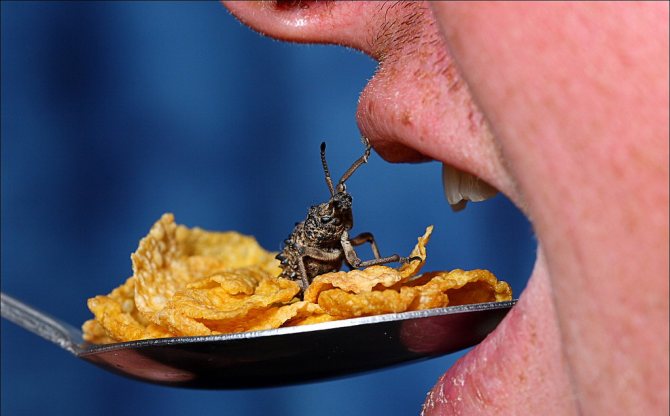

Insects can be the culprit behind dangerous bacteria and fungal infections. That is why you need to immediately get rid of the weevil in the apartment. There are many different ways to do this.
Professional pest control
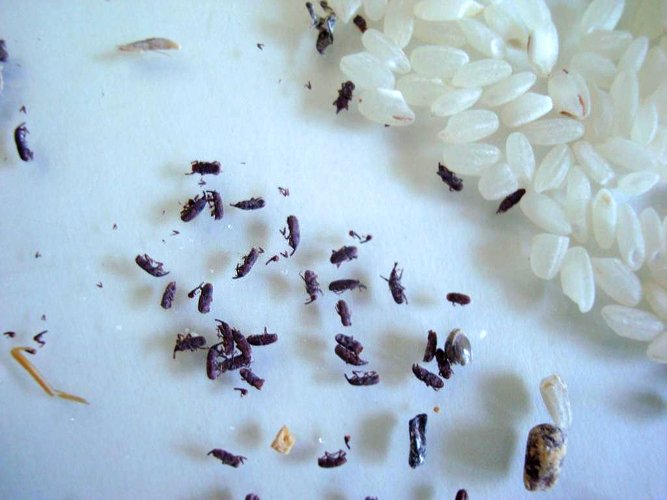

If you cannot drive out the weevils on your own or they have filled the home too much, you should contact a special service. In this case, you can be sure that the pests will be destroyed in all possible places of residence. The methods used by pest controllers to fight insects are as follows:
- The cold fog method uses the principle of mixing pesticide vapors, which are cooled in a generator and mixed with air. A kind of fog is formed, which settles on all objects that have been infected.
- The hot steam method is most effective for large storage areas. They use hot steam, gasoline or gas.
- Barrier protection is used to block all possible crevices through which weevils could penetrate to the reserves. Usually, this method is used as the primary method.
Important!
After using any methods to kill insects, be sure to wash the shelves of the cabinets and dry them. The kitchen, and best of all, the entire home should be well ventilated so that foreign odors do not cause discomfort among family members and animals.
Tips & Tricks
So that weevils do not settle in the apartment, you need to adhere to the basic rules for storing food. So, in the lockers where stocks of cereals, flour and pasta are stored, there should always be perfect cleanliness. It is necessary to abandon the use of paper and plastic bags. The best option would be plastic, tin or glass containers with a tight-fitting lid. They are specially designed for storing food.
Before pouring the cereals into the container, you must first rinse it using a detergent or simply wipe it with a towel dipped in a weak vinegar solution. After that, dry the container well. The optimum moisture level in a bowl for storing flour or cereals can be maintained by placing a natural fabric bag filled with salt on the bottom. Stocks of cereals in the house should not be too large. You need to buy products on the basis that they will last for 2-3 months.
When purchasing flour or cereals, you need to pay attention to when they were produced and packaged. To prevent the likelihood of the formation of insects in flour, you need to take certain preventive measures. If possible, it is worth keeping cereals and pasta in the refrigerator so that the temperature does not exceed 10 degrees.
Prevention: so that bugs do not appear in the house


The best pest control method is prevention. Here, no special expensive funds are needed, but only a little time and patience. It is easier to prevent the invasion of unwanted freeloaders than to spend energy and budget on cleaning the house. Basic rules for maintaining unacceptable conditions for the existence of weevils:
- Pantries and storage cabinets should be kept clean at all times.
- It is worth carefully choosing containers for bulk stocks. These can be glass or metal cans with sealed lids. Plastic special containers are also well suited. It is better not to use paper and polyethylene bags, they will not keep bugs and food will be spoiled.
- Before use, the containers should be rinsed with water and detergent. Then leave to dry completely.
- To avoid creating the ideal humidity level for insect breeding, you can place a cloth bag of salt on the bottom of the container. Such a measure will help remove excess moisture from the food.
- You need to buy cereals and flour supplies for a maximum of 2-4 months. So, the supplies will be constantly updated and will not stale.
- It is worth carefully monitoring the expiration date. Insects often appear in food items that are out of date.
- Adding garlic, bay leaves, nutmeg on shelves or in containers will prevent bugs from appearing.
Prevention of the appearance of weevils
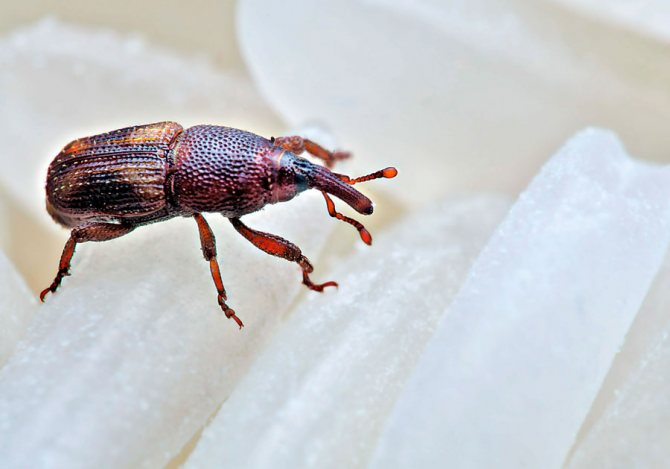

The elephant beetle feeds on food, so it is very important to store it properly.
A few helpful tips:
- Do not practice storing cereals in plastic or paper bags. It is better to use containers made of metal, plastic or glass that close tightly.
- Regularly wipe containers in which cereals or other foodstuffs are stored. For this, a solution of soda or vinegar is used.
- It is advisable to store bulk food products at a temperature not exceeding +5 degrees.
- If there is an excess of moisture, you can put bags of salt on the bottom of the container.
- Do not stock up on food for a long time (maximum for a couple of weeks).
- Do not buy products with an unknown storage term.
- It is better to put deterrent components in each container.
- Several nutmegs can be placed in the flour.
You should always remember that weevils are considered quite voracious insects. If you do not take any measures, then they can easily leave the owner without bulk food. To prevent this from happening, it is better to immediately take care of the correct storage of food.
Structure
Not only in terms of biological parameters, but even evolutionarily, all weevils are divided into two different groups. Long-proboscis — appeared much earlier and are more advanced. They have a long rostrum, often curving downward; the larvae live inside plant tissues or outside.
Short-probed, more primitive, rostrum less than twice its width. Larvae are more likely to live in the ground. For the rest, weevil structure differs little from other coleoptera. Rostrum, pronotum, elytra, wings, abdomen, and three pairs of limbs.
The head of the beetle usually has an elongated spherical shape, turning into a tube, at the end of which there is a mouth opening with small toothed mandibles, and 11-12 labial palps are located there. Below the convex forehead are small compound eyes located along the edges of the head.
The body of the beetle is covered with a hard chitinous cover, which is smooth, with villi or scales. The abdomen has five distinctly visible stubbles. Hind wings are hidden under rigid elytra. In wingless species, the elytra are spliced.
The paws of different species are long or short. The thighs are thickened, the tibiae are thin, and there are two claws at the tip of the tarsus. The weevil larva is light in color, fleshy, without legs. The head is usually darker than the body and has no eyes.
Pronounced mandibles with serrated edges. The pupa is shuttle-shaped; the rudiments of the head, eyes, and legs of the beetle are clearly visible on it. In most species, the female is larger than the male and more perfect in structure.


Five-pointed Weevil / Tychius quinquepunctatus L.
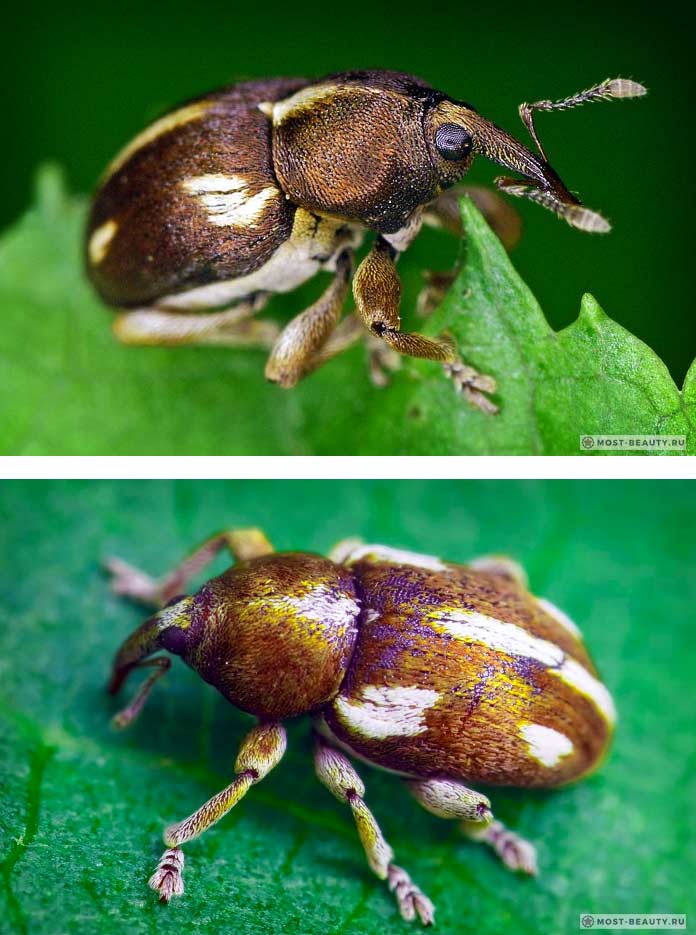

It spreads all over the planet, and is the main pest of legumes. Harmful to plantations of peas, lentils, ranks, by eating leaves, and also gnaws holes in the stems.
In length they grow up to 4 mm, but the larva is 5–7 mm, and it eats the insides of the grain. Above, a small body is covered with reddish scales. Below, the abdomen is white, and there are two specks on the elytra.
They hibernate in the soil, and crawl to the surface when the temperature warms up to 120 ° C. After the first sprouts of peas, one can observe the active migration of the Five-pointed weevil to the places of crop sowing.
9
Food
Different types of weevils are divided into groups according to the type of food. Green weevil is an example of polyphagia in nutrition: it can settle on nettles, birch, maple, apple and many other plants.
The life of other weevils, the so-called. monophages occur within a single plant species. An example is oak fruit, adults feed on oak foliage, and the larval stage is carried out in acorns.
Strawberry weevil feeds on the aerial organs of the strawberry, but it also damages raspberries, i.e. Plants of the same family (oliphagy) serve as food.There are monophages, which, before the appearance of the plants on which they live, feed on other plants.
An adult insect and a larva are united by extreme gluttony, but the larva eats three times more than an adult insect. Weevils actively destroy various parts of plants and cause great damage to agriculture.
Weevils of various species have a great variety of nutrition. Leaves, stems, twigs, plant roots, fallen leaves, fruits, flowers, pollen — this is not a complete list of plant parts that are eaten beetle weevil (saprophytes).
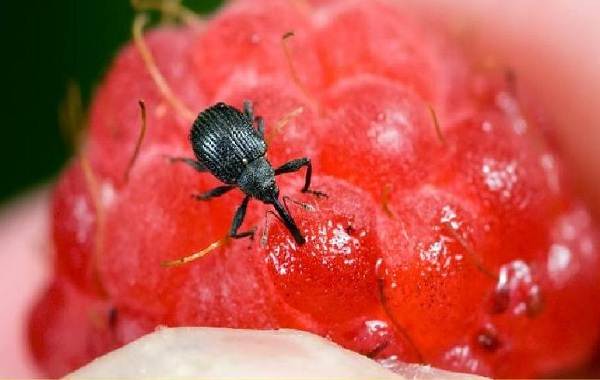

Some species prefer wood, and their larvae make long passages inside the bark. Saprophages prefer decomposed parts of plants and wood, feed on mycelium of fungi.
Often, pests settling on a plant damage its various parts: adults feed on leaves and flowers, and the larvae gnaw at the root system. Weevils often form galls (ugly growths) of plants and live in them.
Trichalophus leucon


The Siberian weevil is the most common species of the Trichalophus mountain family. Inhabited almost all mixed, dark coniferous and deciduous plain forests of western Siberia.
Climbing into gardens and household plots, it begins to eat currant, raspberry leaves, as well as the leaves of fruit trees. Up to 6 individuals can live on one currant bush, so their population is quite numerous.
A new weevil was discovered in 1834 by the famous Altai explorer Friedrich August von Gebler, who was called Fyodor Vasilyevich in the vastness of Russia.
By the way, on our website there is an interesting article about the beautiful places of Gorny Altai that everyone must visit.
6
general information
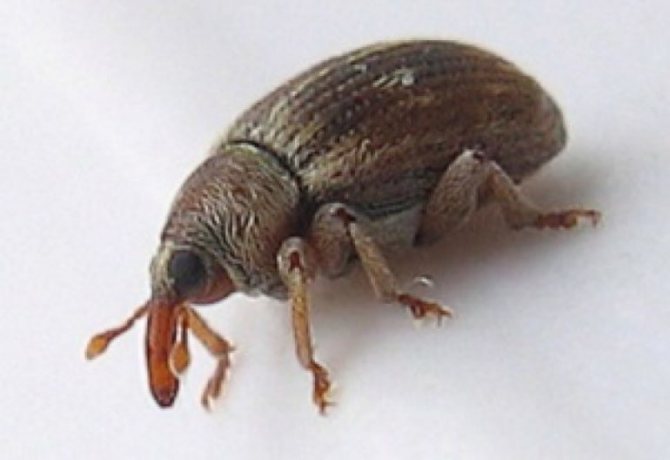

Weevils are often associated with garden pests. However, this is a fairly large type of bugs, it includes many varieties, so these pests can be found in a city apartment. Although most species of weevils prefer countries with a tropical climate, there are about 5 thousand varieties of them in Russia.
During the mating season, they look for places closer to food sources. And then they find themselves in a field with wheat or other crops. In apartments, they can be found among indoor plants or in a warm and cozy kitchen. This is especially true of such a species as the barn weevil. Some studies show that the fight against weevils has been going on for many millennia, this problem was relevant even for Ancient Egypt. Still - after all, the vital activity of these bugs leads to a sharp decrease in yield and the destruction of stocks.
Giraffe Weevil / Trachelophorus giraffa


The most original beetle of all variety. The scientific name Trachelophorus giraffe is derived from its elongated pronotum and head, which resembles the neck of a giraffe.
In addition, this is one of the largest representatives of the family, growing up to 2.5 cm, the body itself is black, but the elytra are bright red. The pronotum and head in males reaches a length of 18 mm, while in females such a "neck" is slightly shorter.
It is found only in Madagascar, being an endemic to this wonderful island. It prefers to settle in trees and bushes of dense forests, because it feeds only on vegetation.
Tailcoat / Lixus paraplecticus


Another unusual and beautiful tailcoat that leads an active lifestyle from the beginning of June to September. In winter, it hibernates.
It was included in the classification by the legendary Swedish scientist Karl Linnaeus in 1758. The body length reaches 24 mm. The color is yellow, and the upper body is lighter than the abdomen. Sometimes dark stripes can be seen on the top.
These weevils have pronounced, elongated elytra. The area is quite extensive, from the expanses of Siberia to the countries of Northern Europe. It is considered a rare species in Sweden and England.
11
Fruit nut / Curculio nucum
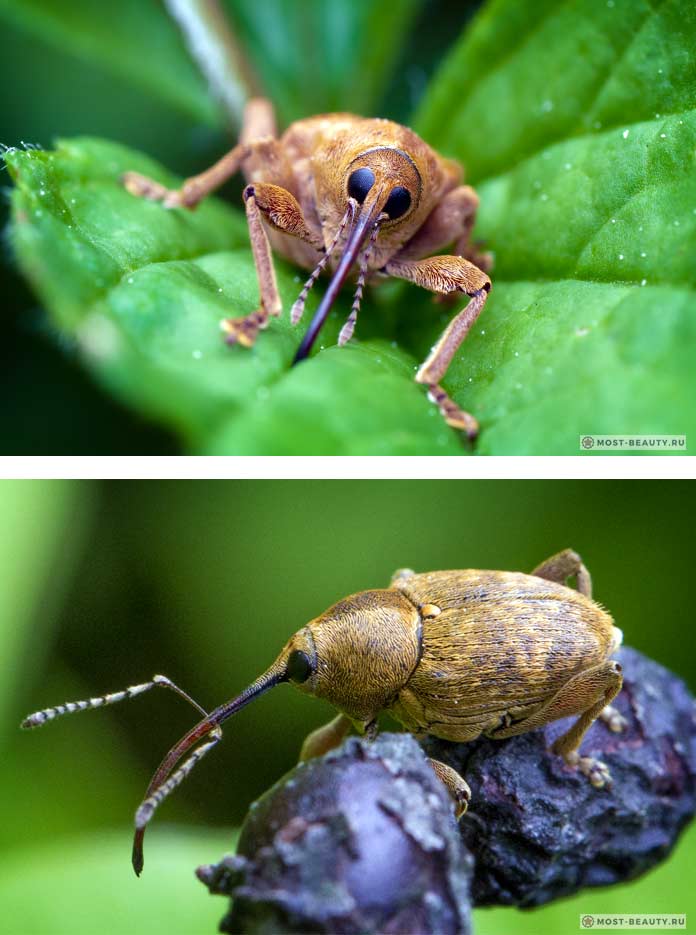

Let's start our story at most-beauty with the most typical species of weevils, which is not devoid of charm. The small body is covered with golden scales. These scales form longitudinal stripes on the pronotum, and yellow spots on the wings.
Adult specimens do not grow more than 9 mm. Widespread fruitful in the oak forests of Europe. In Russia, if you look closely, you can find it in the Crimea, the Caucasus and in the European part of the country.
After wintering, it abundantly eats leaves and fruits of hazel. A favorite delicacy is hazel, hazelnuts, sometimes it can gnaw through a hard acorn.
2
Mr. Dachnik advises: preventive measures
To prevent its appearance, you can take a number of preventive actions, which are as follows:
- Timely cleanse the area from foliage and unnecessary branches.
- Cultivate the land near the trees systematically.
- Plant repellent plants near growing crops such as wormwood.
- Using lime, process trees.
- Promote the appearance of beetle-loving birds with the help of birdhouses, hanging them in the trees.
- Treat periodically with a harmless special tool, for example, Fitoverm.
- Grow away from wild crops.
- In the spring, when the buds appear, the elephants should be dropped, and the trapping belts will be excellent helpers.
- Alternate sowing crops.
A complex and timely effect on the weevil will lead to the desired result: the beetle will be defeated.
Apple Fowler / Otiorhynchus cribricollis
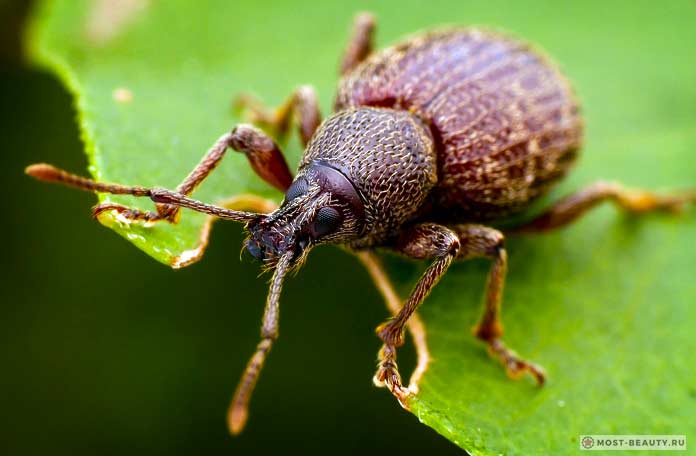

The shiny, varnished beetle belongs to the Entiminae family and was first discovered in 1834.
The Mediterranean region is considered the historical homeland, but by chance, most likely, when importing fruits, it ended up in North America. It took root in a new place, and now it is a danger to agricultural plantings.
The weevil, up to 8 mm in size, eats the vine, bark of fruit trees. They are nocturnal, and during the day they hide in the grass and under fallen leaves.
By the way, there is interesting material on our website about the most beautiful trees for a garden.
10
Lifestyle and habitat
In our country, weevils live throughout Russia, except for the most northern regions. Warm weather + 20-30˚С is considered favorable conditions for development and reproduction. Weevil lives next to those plants that he uses for food.
So the apple weevil lives close to orchards, the pine elephant is more common in coniferous forests. In spring, they can be seen on the weeds that they feed on before the emergence of cultivated plants.
The insect overwinters in adult form or in the phase of larva and pupa in leaf litter, soil, in folds of bark and other protected places. Only adults hibernate in the soil. With the onset of warmth + 7-9˚C, the first beetles begin to appear, but mass emergence occurs when the temperature is above 10˚C.
Some adults enter diapause and stay in the soil for the entire warm season, appearing on the surface only next spring. During the summer, beetles go through a full life cycle of development. The weevil lives in secret, buried in the topsoil at night or during a cold snap.


Weevil on strawberries
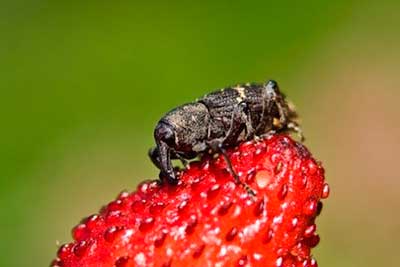

The presence of a weevil in the garden is usually discovered too late and becomes an unpleasant surprise.
Elephant beetles appear imperceptibly, act covertly, and the damage from their activity is irreparable: the lush seedlings have withered, the buds have crumbled, the ovaries and young rosettes have died. To prevent this from happening, you need to recognize the pest in time.
Silver Weevil / Phyllobius argentatus
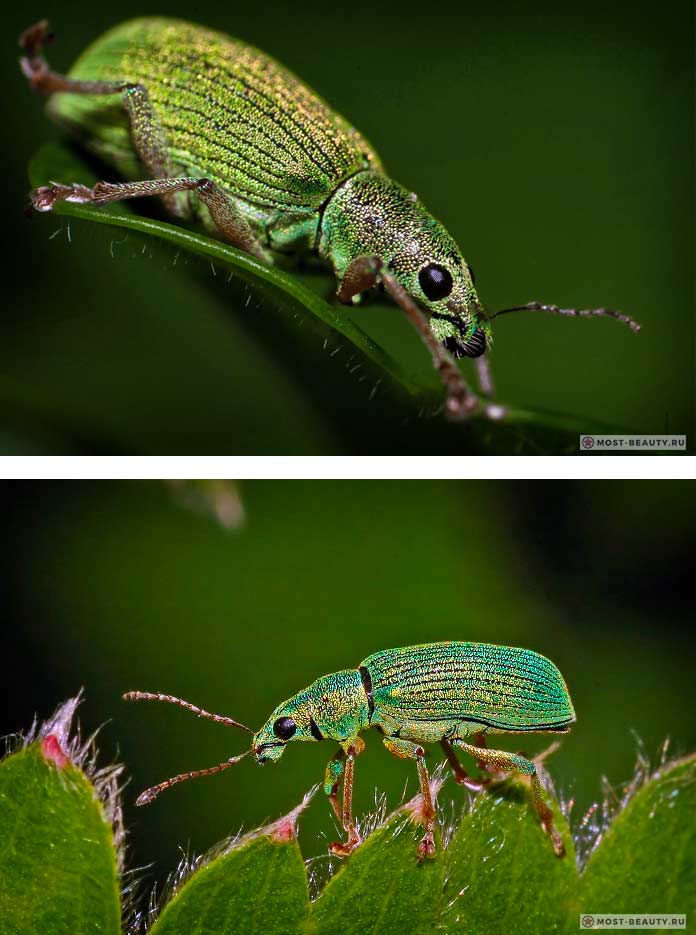

This beetle is also called the leafy golden weevil, as it settles on the leaves of trees. Refers to skosory.
A small body, only 3-6 mm, is covered with golden scales, which give the beetle an unusual beautiful appearance. Legs and long antennae are yellow.The eyes are rather large in relation to the body.
It is found in European countries, and Russia is inhabited by deciduous forests in the central part of the country. There are small populations in the North Caucasus.
12
Food storage rules
For storing cereals and pasta, it is recommended to purchase containers made of food-grade plastic, glass or stainless steel with tight-fitting lids. It is not recommended to use paper bags, as the weevil will chew through them easily. Before reuse, the containers must be rinsed with a solution of salt and soda. To do this, dilute 1 tsp. in 1 tbsp. water. Mustard and vinegar, taken in the same proportions, help.


Loose food should be stored in dry containers in a cool, dark place, preferably on the bottom shelf of a kitchen cabinet. To repel insects, put a dried orange peel on the bottom of the container.
Apple Blossom Beetle / Anthonomus pomorum
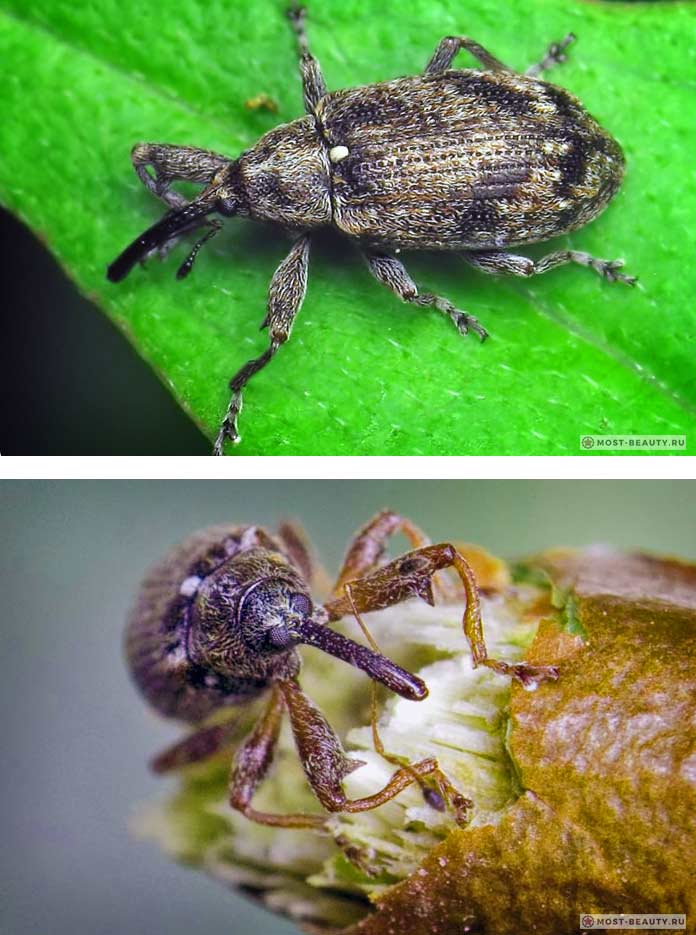

A dangerous agricultural pest has spread almost all over the planet, especially in places where apple orchards are spread. It affects domestic pears and apple trees, but can also inhabit wild species.
Small, only 4-5 mm weevils, have a brown-brown color and a pronounced elongated head. On the shields, there are light stripes framed by a black border. Male and female can be distinguished by the length of these stripes, since they are longer in females.
The larva eats the ovary of the buds of fruit trees, but the adults destroy the leaves.
3
Interesting Facts
It's believed that weevilis definitely an insect pest. But in Brazil and Australia, weevils are used to kill weeds. So, in Australia, a nondescript beetle saved Lake Victoria from the invasion of a malicious weed called water hyacinth. A weevil was brought to Russia to cleanse reservoirs from weed salvia algae, its adults and larvae are capable of destroying huge volumes of an aquatic plant.
Scientists have found that the legs of a weevil are attached to the body according to the principle of a screw and a nut. On the legs there is a semblance of a thread, which, as it were, is screwed into the body, which provides the beetles with ease of movement.
Common coat / Lixus iridis


An unusual beetle with an elongated body has chosen the warm regions of Europe and Asia. It is also found in the Middle East. Named after the Iris plant.
Adults grow up to 22 mm in length, and the pronotum is tapered. The color is yellow or gray-yellow. The elytra are strongly elongated, and the tarsi are long and thin.
Adult beetles and developing larvae actively eat the ovary and leaves of plants from the Umbelliferae family. Getting into vegetable gardens, it harms crops of carrots, parsley, celery.
7


